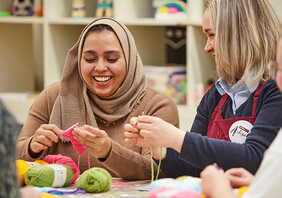How to Make an Air Dry Clay Plant Pot
Craft the perfect clay pots for your plants! It's the perfect way to refresh the botanicals in your home or perhaps create a handmade gift for a loved one. Get creative and roll up your sleeves!
Clay pots are fun to make and spruce up your home décor effortlessly! Display plants in style, use your pot to store stationery, or add yours to create a focal point in a room. You can even personalise your clay pot by decorating it in your own way to make it extra-special.
Project and instructions by Elizabeth Hardy
You will need
You Will Need
* Air Drying Clay
* Modelling Tools
* Decoupage Medium
* Impression Mats
* Rolling Pin
* Acrylic Paint - Grey, White
* Compass
* Paintbrushes
* Scissors
* Ruler
* Length of String or Yarn
* A4 Sheet of Paper
* Pot of Water
* Greaseproof Paper
* Drying Rack
How To Make
First measure out a template for the base of your pot.
For a 13cm pot you will need to use approximately 1.5kg of air-drying clay, for a 15cm pot you will need to use approximately 2kg.
Halve this and measure a compass to size, for a 13cm pot measure to 6.5cm, for 15cm measure to 7.5cm.

Use the compass to draw a circle out of a piece of paper or card and cut it out.

Next work out the length that you'll need to make the slab of clay to reach around the circumference of the base.
To do this you'll need to multiply the diameter of the base of your pot by 3.14. For a 13cm pot this is roughly 41cm, for a 15cm pot this is roughly 47cm.
Then measure a piece of string or yarn to this length and use it as a measure.


Next, roll out roughly a third of the clay until it is around 3cm thick, place the template on top and use a blunt knife or wooden clay tool to cut the excess clay away from the pot.

Roll out the rest of the clay lengthways until it is roughly 2cm thick, to the size of the length of yarn, and measures to the depth of the pot desired.
For a standard pot match the depth to the circumference. Cut out using a ruler.


Add any desired textures to the clay.


Create a series of marks along one edge of the length of clay and also around the edge of the base.
This will help the clay to stick together. Use a small amount of water along these marks.

Take the slab and carefully wrap around the base of the pot- this step can be quite tricky so be patient with it and trim off as much of the length as necessary.
If it goes wrong, you can roll out the clay again! Join the slab at either end by using a tool to mix the clay from either side together.

Join the base with the side of the pot on the inside using a tool or your hand.
Use both hands one on the inside and one on the outside to straighten the slab- the clay can often start to bow inwards because of the weight but keep working your way around the pot in this motion to coax the sides straight.


For extra strength join the base from the bottom.
Hang a small part of the edge of the pot off of the edge of a board or table and work from underneath in small sections as the pot will be too delicate to lift.
Leave to dry. Drying times will depend on ventilation and heat of the room, the pots pictured took around 5-7 days to dry completely.

Once dry use sandpaper to even out any edges and remove glaring imperfections. The pots may be a little wonky, but this is part of the charm!
Next, remove any dust with a dry cloth and paint in desired colours. Leave to dry.


Once dry, use Mod Podge to glaze the pots and leave to dry.

Once dry the pot is ready to be used!















